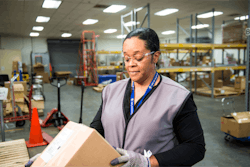
Editor's Note: In early 2007, APL Logistics launched a new continuous improvement program that has yielded more than $22 million in savings. In this exclusive account, the company's director of process improvement, Charlie Jacobs, who has headed the initiative from day one, explains why he thinks the program's tools have worked so well for his organization – and what other companies can do to pave the way for similar success.
Over the past four years, I've had a privilege few logistics professionals get: teaching hundreds of people the ins and outs of quality improvement principles. Just as important, I've had a chance to see the extraordinary results they've been able to achieve when they've taken what they learned, shared it with their locations and put it into action.
These results aren't nebulous – or negligible; their tangible savings have ranged from a few thousand dollars to more than a million (and counting).
They also aren't unusual, because with the right resources and level of commitment, any company can make continuous improvement disciplines work equally hard for them.
Whether you've just begun contemplating a quality program or have already implemented one with only moderate success, I hope this "FAQ" about the early years of our program will provide you with a little high-quality inspiration of your own.
How did you decide which quality discipline to use?
As anyone who's ever been involved in formal continuous improvement knows, there are several highly credible quality disciplines to choose from, including Lean, Six Sigma and JDI (Just Do It). But not every one is a perfect fit for every company.
After carefully weighing the pros and cons of several approaches, we elected to kick our program off with Lean because of the combination of structure and flexibility it offered. Like Six Sigma, it's a highly quantitative discipline. However, it's also considerably less data-intensive, which made it a far better option for our particular operations at the time.
Lean also offered the advantage of having shorter project timelines – three to six weeks -- which meant our company's teams could start generating positive results almost immediately. That was a big help in terms of getting quick buy-in throughout the company and the pay-it-forward funding we needed to train more teams.
Some might argue that we should have started with JDI (which we wound up adding to our initiative a couple of years later), since it's even less data-intensive. But truthfully, I don't think it would have been worked nearly as well for us if we hadn't had a solid foundation of Lean to draw from first.
How did you decide whom to train?
When it comes to getting professionals trained in Lean, some companies think it's best to train a handful of professionals from within their organizations and then let them manage projects on a go-forward basis. We preferred the more grassroots approach of training as many employees as possible and then letting those employees take charge of owning the process and training some of their fellow employees.
This "viral" methodology enabled us to train hundreds of people within our organization in a fairly short period of the time, and that in turn enabled us to begin tackling more projects sooner. Viral training also enabled us to create considerably more continuous improvement experts and advocates than we otherwise would have had. And you can never have too many of those.
What did your training consist of?
As the training phase of APL Logistics' program began, each facility going through our Lean training was instructed to identify a problem or challenge it wanted to address and create a team that would address it.
That team then attended an in-house workshop, where it used Lean tools to tackle the issue and find a solution. Afterwards, the team returned to work to put that solution into action.
Even though it would have been considerably faster for us to train teams using hypothetical scenarios or doing something simple like addressing the challenge of building a better paper airplane (which is what some companies prefer to do), we're incredibly glad we chose the real-life, real-stakes approach because a) it was a good use of team members' valuable time and b) it enabled team to see that even though Lean tools seem cerebral, they're actually highly practical – and applicable.
Once they saw how well these tools worked, they didn't have to be sold on the merits of using them; the merits were plain to see.
What kinds of projects have your Lean teams addressed – and which have yielded the highest dividends?
To date, our company has completed more than 440 Lean projects addressing just about any activity that can take place in a distribution center, including: space utilization, case picking, rhino crating, unloading, receiving, paper flow, labeling, clerical activities, parcel productivity, corrugated disposal and assemble-to-order.
Our current project record-holder ($1.6 million in savings) addressed a Value-Added Services process for a major retail customer that streamlined the flow of product. However bear in mind that this is an extraordinary case. If you instruct all of your teams to swing for the bleachers and try to replicate such a success right out of the gate, you may miss out on a lot of other smaller opportunities that could eventually add to big savings or improvements, too.
Did you ever encounter any resistance to your program? If so, how did you address it?
You'll always come across skeptics when it comes to continuous improvement programs, especially if an organization has already spent considerable money on sending people to training and then failed to see them apply it – or if people have been with your company long enough to remember similar programs that came and went with little result.
The key, I think, is to get some program-related points on the board early so that people realize your initiatives aren't just a lot of talk. For example, during the early years of the program, we encouraged our teams to focus on quick wins and incremental improvements. Within the first year, we had saved $302,000, and those results were enough to inspire a lot of people and demonstrate that the tools really worked.
It's also important to make a quality program as quantitative and measureable as possible. There need to be clear goals set for the program and deliverables expected of it. And there needs to be clear and frequent communication about your organization's progress in attaining them.
And of course, you can always enhance acceptance with the help of financial incentives. Bonuses, prizes and ties to compensation all have an uncanny way of motivating many people.
Your company's continuous program is almost five years old now. Is it hard to maintain results and keep enthusiasm for it alive?
It probably would be if we'd merely launched the program, trained a few teams and decided our work was done.
But our company has always operated on the philosophy that even continuous improvement programs need continuous improvement, so we're constantly looking for ways to keep ours fresh and interesting.
Sometimes that's meant introducing new disciplines when it looks like teams are ready for them, which is why we added Six Sigma and JDI to our efforts in 2010. Other times it's meant increasing training options (we've just begun offering some sessions via the web), upgrading systems so project information could be shared more easily or creating some sort of internal publication to help keep people better informed.
We've also begun rolling out the program to other corporate functions and other geographies. In fact, one of our most successful team leaders is in the process of launching it in Asia.
The bottom line is, there's always a way to make the concept of improvement fresh and interesting. And, as you can tell from our savings, millions of reasons why companies should.
About the Author
Charlie Jacobs
Charlie Jacobs is director of process improvement at APL Logistics and heads up the company's Lean program.

















